#Digester Biogas
Explore tagged Tumblr posts
Text
From Waste to Wealth: Transforming Trash into Sustainable Success
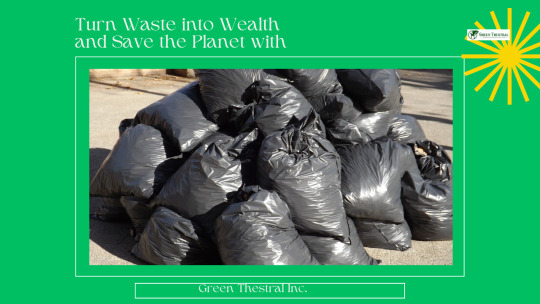
In a world grappling with environmental concerns and limited resources, the concept of "waste to wealth" holds tremendous promise. Waste, once perceived as a burden, is now recognized as a potential asset that can be transformed into a valuable resource. From recycling and upcycling to innovative technologies, this article explores the various ways in which we can turn waste into wealth, promoting sustainable practices and economic growth.
The Power of Recycling
Recycling has become a household term, but its significance cannot be overstated. By collecting and processing waste materials such as plastic, paper, glass, and metal, we can divert them from landfills and give them a new life. The recycling industry not only reduces the strain on our planet's resources but also creates employment opportunities and contributes to the circular economy. Governments and businesses worldwide are investing in recycling infrastructure and raising awareness to maximize the potential of waste recycling.
Upcycling: Adding Value to Discarded Materials
While recycling focuses on breaking down waste materials, upcycling takes a different approach by transforming them into products of higher value. Instead of downgrading the material, upcycling adds creativity and innovation to turn waste into desirable and unique items. From repurposing old furniture to creating fashion accessories from discarded textiles, upcycling has gained popularity as a sustainable alternative to conventional manufacturing. This practice not only reduces waste but also fosters creativity and entrepreneurial opportunities.
Innovative Technologies for Waste Management
Advancements in technology have revolutionized waste management, offering exciting possibilities for a greener and more sustainable future. One groundbreaking technology that has gained significant attention is waste-to-energy conversion. This process involves transforming organic waste into valuable biogas or biofuels through various techniques such as anaerobic digestion and pyrolysis.
Anaerobic digestion is a biological process that breaks down organic waste in the absence of oxygen, producing biogas as a byproduct. The organic waste, such as food scraps, agricultural residues, and sewage sludge, is placed in an enclosed tank where anaerobic bacteria decompose the waste and generate methane-rich biogas. This biogas can then be used as a renewable energy source for electricity generation, heating, or even as a vehicle fuel. The remaining digestate, which is a nutrient-rich residue, can be utilized as a natural fertilizer for agriculture, closing the loop on waste management.
Pyrolysis is another waste-to-energy conversion process that involves heating organic waste in the absence of oxygen, resulting in the production of biochar, bio-oil, and syngas. Biochar is a stable carbon-rich material that can enhance soil fertility and carbon sequestration, while bio-oil and syngas can be utilized as energy sources. This process can be applied to various types of organic waste, including agricultural residues, forestry waste, and even certain types of plastics.
The waste-to-energy conversion technologies not only offer a sustainable solution for waste management but also contribute to the production of renewable energy. By diverting organic waste from landfills, these processes help reduce greenhouse gas emissions, as landfilling organic waste leads to the release of methane, a potent greenhouse gas. Furthermore, the utilization of biogas and biofuels as energy sources helps decrease reliance on fossil fuels, mitigating the negative impacts of climate change and supporting the transition to a low-carbon economy.
While waste-to-energy conversion primarily focuses on organic waste, technology is also advancing to address the challenges posed by non-recyclable plastics. Traditional recycling methods often face limitations when it comes to certain plastics, such as multilayered packaging and mixed plastics that are difficult to separate and process. To tackle this issue, innovative technologies like plasma gasification and chemical recycling are being explored.
Plasma gasification is a high-temperature process that converts solid waste, including non-recyclable plastics, into a synthetic gas known as syngas. This syngas can be further utilized as a source of energy or as a chemical feedstock for the production of various materials. The process employs extremely high temperatures generated by an electric arc or plasma torch, breaking down the waste into its elemental components.
Chemical recycling, also known as advanced recycling or feedstock recycling, involves breaking down plastics into their molecular building blocks through various chemical processes. These building blocks can then be used as raw materials to produce new plastics, reducing the demand for virgin fossil fuel-based plastics. Chemical recycling has the potential to address the challenges posed by mixed plastics, post-consumer plastics, and plastics that are difficult to recycle through traditional mechanical processes.
By exploring and implementing these innovative waste management technologies, we can significantly reduce waste generation, minimize environmental pollution, and create valuable resources. Waste-to-energy conversion technologies provide a sustainable alternative to conventional waste disposal methods, generating renewable energy and reducing greenhouse gas emissions. Additionally, plasma gasification and chemical recycling offer solutions to the challenges posed by non-recyclable plastics, fostering a more circular economy and reducing reliance on fossil fuels.
As technology continues to advance and awareness of environmental issues grows, it is crucial to support and invest in these innovative waste management solutions. Collaboration between governments, businesses, and individuals is vital to drive the adoption of these technologies, promote sustainable practices, and pave the way for a greener and more sustainable future. By harnessing the power of technology, we can transform waste into wealth, mitigate environmental impacts, and build a more resilient planet for generations to come.
The Circular Economy Approach
The circular economy is an economic system that aims to minimize waste generation and maximize resource utilization. It emphasizes the concept of "closing the loop" by designing products that are durable, repairable, and recyclable. Through practices like product life extension, sharing economy models, and responsible consumption, the circular economy reduces the extraction of raw materials and promotes the efficient use of existing resources. By adopting a circular approach, businesses can not only reduce waste and costs but also enhance their brand reputation and contribute to environmental preservation.
Waste Management as a Business Opportunity
The transition from waste to wealth has opened up new avenues for entrepreneurs and innovators. Startups are emerging in various sectors, focusing on waste management and resource recovery. From companies that convert food waste into fertilizer to those that produce eco-friendly packaging materials, these businesses demonstrate the potential for profit while addressing environmental challenges. Governments and investors are supporting these ventures, recognizing their ability to create jobs, drive economic growth, and contribute to a sustainable future.
Community Engagement and Education
Creating a sustainable future requires collective action, and community engagement plays a crucial role. Education and awareness campaigns can help change people's attitudes and behaviors towards waste management. By promoting responsible consumption, waste segregation, and recycling practices, individuals can actively participate in the waste-to-wealth movement. Community initiatives, such as local recycling centers, composting programs, and upcycling workshops, provide platforms for collaboration and knowledge-sharing. Together, we can build a more sustainable and prosperous society.
Conclusion
The waste-to-wealth concept holds immense potential for addressing environmental challenges and creating economic opportunities. By embracing recycling, upcycling, and innovative technologies, we can transform waste into valuable resources, reduce landfill burden, and mitigate the depletion of natural resources. The circular economy approach and the rise of waste management startups further demonstrate the viability of turning waste into a profitable enterprise. However, achieving lasting change requires collective efforts, community engagement, and continuous education. Let us seize the opportunity to turn waste into wealth and build a sustainable future for generations to come.
#Waste to wealth: Transforming trash into valuable resources#Innovative waste management technologies for a sustainable future#Turning waste into renewable energy: Waste-to-energy conversion#From waste to biogas: The power of anaerobic digestion#Waste-to-energy: A greener solution for waste management#Sustainable success: Converting waste into wealth#Waste management revolution: Unlocking the potential of technology#Waste-to-energy technologies: A pathway to a circular economy#Pyrolysis: Transforming organic waste into biofuels#Plasma gasification: Tackling non-recyclable plastics for a greener future#Chemical recycling: Reshaping the plastic waste landscape#Waste-to-energy: A sustainable approach to waste management#Waste transformation: From burden to economic opportunity#Recycling and upcycling: Building wealth from waste#Waste management innovations: Redefining sustainable practices#Waste-to-wealth revolution: Creating value from discarded materials#Turning waste into resources: A roadmap to sustainability#Waste conversion technologies: Bridging the gap between waste and wealth#Waste-to-energy solutions: Powering a greener tomorrow#Sustainable waste management: Embracing the waste-to-wealth concept#Upcycling for a prosperous future: Redefining waste utilization#Waste-to-energy advancements: Paving the way for a circular economy#Waste-to-wealth strategies: Maximizing resource efficiency#Transforming waste into valuable commodities: The future of waste management#Waste conversion technologies: Innovations for a sustainable world#Waste-to-wealth practices: Shaping a more prosperous society#Waste management reimagined: Harnessing technology for a greener planet#Turning waste into renewable resources: The power of waste-to-energy#Circular economy and waste transformation: A pathway to sustainable growth#Waste-to-wealth initiatives: Driving economic and environmental benefits
2 notes
·
View notes
Text
Anaerobic Digestion Systems Market Size, Share, Forecast, & Trends Analysis
Meticulous Research®—a leading global market research company, published a research report titled ‘Anaerobic Digestion Systems Market—Global Opportunity Analysis and Industry Forecast (2024-2031)’. According to this latest publication from Meticulous Research®, the anaerobic digestion systems market is expected to reach $32.1 billion by 2031, at a CAGR of 10.2% from 2024 to 2031.
The growth of this market is primarily driven by the rising demand for renewable energy sources, government initiatives supporting the development & adoption of anaerobic digestion systems, the growing need for safe waste disposal, and increasing awareness regarding the benefits of anaerobic digestion systems. However, competition from other renewable energy sources and the high initial investment requirements & operating costs of anaerobic digestion systems restrain the growth of this market.
Furthermore, the increasing use of anaerobic digestion systems in sewage & wastewater treatment and the integration of advanced technologies into anaerobic digestion systems are expected to generate growth opportunities for market stakeholders. However, operational issues with anaerobic digestion systems are a major challenge impacting market growth. Additionally, the increasing use of co-digestion is a prominent trend in the anaerobic digestion market.
The anaerobic digestion systems market is segmented by offering, feedstock type, capacity, application, and sector. The report evaluates industry competitors and analyzes the market at the regional and country levels.
Based on offering, in 2024, the hardware segment is anticipated to hold the dominant position in the anaerobic digestion systems market, with a share of over 46.7%. The segment’s large market share is attributed to the growing demand for renewable energy sources and sustainable waste management practices and the increasing use of digesters, generators, compressors, gas storage tanks, pumps, pipes, and other equipment necessary for the anaerobic digestion process.
Based on feedstock type, in 2024, the industrial waste segment is anticipated to hold the dominant position in the anaerobic digestion systems market, with a share of over 25.6%. The segment’s large market share is attributed to increasing government regulations promoting the adoption of green technologies, the high generation of organic waste in the industrial sector, and the increasing adoption of anaerobic digestion systems among industrial organizations.
Based on capacity, in 2024, the medium-scale segment is anticipated to hold the dominant position in the anaerobic digestion systems market, with a share of over 41.4%. The segment’s large market share is attributed to the increasing use of anaerobic digestion systems with a capacity between 500KW-3MW for commercial and industrial operations and the growing need to process large volumes of organic waste for biogas production in large-scale renewable energy projects.
Based on application, in 2024, the agricultural & industrial waste management segment is anticipated to hold the dominant position in the anaerobic digestion systems market, with a share of over 42.1%. The segment’s large market share is attributed to the integration of anaerobic digestion systems into agricultural waste management and the increasing demand for anaerobic digestion systems across various industries such as food & beverage, pulp & paper, and agriculture.
Based on sector, in 2024, the energy & utilities segment is anticipated to hold the dominant position in the anaerobic digestion systems market, with a share of over 32.2%. The segment’s large market share is attributed to the increasing need to reduce greenhouse gas emissions, the rising acceptance of biofuels, and the need for alternative renewable energy sources.
Based on geography, in 2024, North America is anticipated to hold the dominant position in the anaerobic digestion systems market, with a share of over 34.3%. The presence of prominent anaerobic digestion systems players such as Evoqua Water Technologies Corp. (U.S.), Zero Waste Energy, LLC (U.S.), Capstone Green Energy Holdings, Inc. (U.S.), and Bioenergy Devco, LLC (U.S.) is expected to contribute to the high revenue share of this region. North America’s major market share is mainly attributed to its developed waste management infrastructure, stringent environmental regulations, high food waste levels, and a growing focus on renewable energy are driving the growth of the anaerobic digestion systems market.
Key Players:
The key players operating in the anaerobic digestion systems market are Kanadevia Inova Group (A Part of Hitachi Zosen Corporation) (Switzerland), Evoqua Water Technologies Corp. (U.S.), EnviTec Biogas AG (Germany), Nature Energy Biogas A/S (A Part of Shell plc) (Denmark), Biokraft International AB (Sweden), VWS (UK) Ltd (A Part of Veolia Environnement) (U.K.), Renewi plc (U.K.), Capstone Green Energy Holdings, Inc. (U.S.), Bioenergy Devco, LLC (U.S.), PlanET Biogas Group GmbH (Germany), Biogen (UK) Ltd (U.K.), Agrinz Technologies GmbH (Austria), Zero Waste Energy, LLC (U.S.), Agraferm Technologies AG (Germany), Bioquadrat Energie- und Wassertechnik Holding GmbH (Austria), and AAT Abases- und Abfalltechnik GmbH (Austria).
Download Sample Report Here @ https://www.meticulousresearch.com/download-sample-report/cp_id=5522
Key Questions Answered in the Report-
What is the revenue generated by the sale of anaerobic digestion systems?
At what rate is the global demand for anaerobic digestion systems projected to grow for the next five to seven years?
What is the historical market size and growth rate for the anaerobic digestion systems market?
What are the major factors impacting the growth of this market at global and regional levels?
What are the major opportunities for existing players and new entrants in the market?
Which offering, feedstock type, capacity, application, and sector segments create major traction in this market?
What are the key geographical trends in this market? Which regions/countries are expected to offer significant growth opportunities for the manufacturers operating in the anaerobic digestion systems market?
Who are the major players in the anaerobic digestion systems market? What are their specific product offerings in this market?
What recent developments have taken place in the anaerobic digestion systems market? What impact have these strategic developments created on the market?
Contact Us: Meticulous Research® Email- [email protected] Contact Sales- +1-646-781-8004 Connect with us on LinkedIn- https://www.linkedin.com/company/meticulous-research
#Anaerobic Digestion Systems Market#Anaerobic Digestion Systems#Anaerobic Digestion#Biogas Plan#Combined Heat and Power#Waste-to-Energy#Digestate
0 notes
Text
Methane Biogas Digester - ELI Biosciences
ELI Biosciences offers advanced methane biogas digesters, turning organic waste into clean energy. Reduce waste, cut emissions, and power sustainability today! Visit now !
0 notes
Text
High-Quality Biogas Digesters by Coepenviro Tanks
Coepenviro Tanks is a leading provider of Glass-Fused-to-Steel (GFS) Tanks, offering top-notch solutions for various industrial and environmental needs. Among our innovative products are biogas digesters designed for sustainable energy production, combining durability, efficiency, and eco-friendliness.
Glass-Fused-to-Steel Tanks for Biogas Digesters
Our Glass-Fused-to-Steel Tanks are engineered with precision to ensure optimal performance in biogas production. The glass coating provides excellent resistance to corrosion, making these tanks ideal for handling aggressive substances. Whether you require a ZnAl steel tank for robust construction or steel bolted tanks for easy installation, our solutions are tailored to meet diverse requirements.
Applications of GFS Tanks
Rainwater Harvesting: Our GLS Tanks for Rainwater Harvesting are perfect for storing harvested rainwater, offering a sustainable water storage solution.
Wastewater Management: Coepenviro’s wastewater tanks are designed to handle industrial and municipal wastewater with high efficiency and reliability.
Fire Protection: We offer Fire Protection GFS Tanks that comply with safety standards, ensuring reliable fire suppression systems.
Potable Water Storage: For clean and safe drinking water storage, our Potable Water Storage GLS Tanks are the ideal choice.
Advantages of Coepenviro Tanks
Durability: With a glass-fused coating, our tanks resist corrosion and wear, ensuring longevity.
Easy Installation: Our steel bolted tanks are prefabricated and easy to assemble, saving time and labor costs.
Versatility: Suitable for multiple applications, including biogas storage, industrial use, and potable water storage.
Global Reach: We are not only GFS Tank Suppliers in India but also cater to clients worldwide, including Glass-Fused-to-Steel Tanks in Kenya.
Why Choose Coepenviro Tanks?
As a leading bolted tank supplier, we take pride in delivering high-quality bolted tanks that meet international standards. Our products are widely recognized for their robust design, innovative features, and cost-effectiveness. Whether you need steel-coated tanks for industrial storage or specialized industrial storage tanks for biogas digesters, Coepenviro is your trusted partner.
Conclusion
Coepenviro Tanks stands out as a premier provider of Glass-Fused-to-Steel Tanks and related storage solutions. From wastewater tanks to fire protection GFS tanks, our extensive range of products addresses diverse industrial and environmental needs. For high-quality biogas digesters and other tank solutions, trust Coepenviro’s expertise and commitment to excellence.
#Biogas Digester in India#Anaerobic Storage#Customized GFS Tank#Agricultural Biogas Plant#Biomass Digester#Bio-Digester Tank#Biogas Production System#Anaerobic Digester#Coep Enviro biogas project#Industrial Biogas Digester
0 notes
Text
youtube
0 notes
Text
Some things to know: this article describes new technology in mega dairies be responsible for 18,000 cows dying in a single fire, because they were trapped in cages and couldn’t leave. Also, technology involved in improving air circulation to avoid methane buildup caused the fans to blow the fire around the building and make the entire problem worse. 
Frustratingly, this article tries to paint the people who put the cows in this condition as victims of circumstances “beyond their control“ and almost implying that the people who lost so much “property“ in the forms of dead animals are the real victims, not the cows.
It is also worth knowing that in the last quarter of the article you do see a photo of a pile of cow corpses. If that is something you don’t want to see, then do not read this article or have someone read it to you if you want the information but don’t wanna see the pictures.
#tw: animal death#tw: mass death#factory farming#biogas digesters#biogas digester#manure vacuum trucks
1 note
·
View note
Text
youtube
How is food waste recycled? It is widely acknowledged that food losses and waste (FLW) is a serious global problem and accounts for one-third of the CO2 emissions released each year. According to the Food and Agriculture Organization of the United Nations (FAO), approximately 1.3 billion metric tons of food are estimated to be lost or wasted globally each year. However, efforts to reduce food waste and improve surplus food management will never eliminate all food waste, so food waste recycling plays an important part in reducing greenhouse gas emissions and harnessing an otherwise wasted resource.
What happens to the discarded food, and how is food waste recycled?
#agriculture#biogas#engineering#food waste#operations#biogas plant#anaerobic digestion#food waste recycling#Agrivert#Youtube
1 note
·
View note
Text
Bio-Energy Market Report, Research Outlook, Products, and Application 2017 – 2032

Overview of the Bio-Energy Market:
The production, delivery, and use of energy obtained from biomass resources are all part of the bioenergy market. The term "biomass" refers to organic materials that can be used to create energy through a variety of processes, such as combustion, gasification, and biochemical conversion, such as plants, agricultural residues, forestry residues, and organic waste. Biomass may be refilled through sustainable practises, which is why bioenergy is regarded as a renewable energy source.
The global bioenergy market size was valued at $102.5 billion in 2020, and is expected to reach $217.8 billion by 2030, registering a CAGR of 7.6% from 2021 to 2030.
Key Factors Driving the Bio-Energy Market:
Transition to Renewable Energy: The bioenergy sector is significantly influenced by the global move to renewable energy sources. As a renewable and environmentally friendly substitute for fossil fuels, bioenergy helps to slow global warming by lowering greenhouse gas emissions.
Energy Independence and Security: By utilising a variety of energy sources, bioenergy can help with energy security. Countries with plentiful biomass resources can increase their energy independence and decrease their reliance on imported fossil fuels.
Government Policies and Incentives: Countless countries around the world have put policies and incentives in place to encourage the use of bioenergy. These policies stimulate the creation and application of bioenergy technology and include feed-in tariffs, renewable energy objectives, tax incentives, and subsidies.
Concerns for the environment and carbon neutrality: Bioenergy is regarded as a carbon-neutral energy source because the carbon dioxide.
Waste Management and Circular Economy: Bio-energy can play a role in waste management by utilizing organic waste materials for energy production. This contributes to the circular economy concept, where waste is seen as a resource, promoting sustainable resource utilization and waste reduction.
Technological Advancements and Efficiency Improvements: Advances in bio-energy technologies, such as improved biomass conversion processes, biofuel production techniques, and efficient combustion systems, enhance the efficiency and economic viability of bio-energy. Technological advancements make bio-energy more competitive and attractive in the energy market.
Regional Variations in Biomass Resource Accessibility: There are regional differences in the accessibility and availability of biomass resources. Countries with an abundance of biomass resources, such as forestry waste and agricultural wastes, provide favourable conditions for the development of bioenergy.
Rural Development and Job Creation: By generating jobs in the biomass production, processing, and bioenergy plant operations, bioenergy initiatives frequently have a favourable effect on rural regions. Rural development and economic expansion are aided by this.
We recommend referring our Stringent datalytics firm, industry publications, and websites that specialize in providing market reports. These sources often offer comprehensive analysis, market trends, growth forecasts, competitive landscape, and other valuable insights into this market.
By visiting our website or contacting us directly, you can explore the availability of specific reports related to this market. These reports often require a purchase or subscription, but we provide comprehensive and in-depth information that can be valuable for businesses, investors, and individuals interested in this market.
“Remember to look for recent reports to ensure you have the most current and relevant information.”
Click Here, To Get Free Sample Report: https://stringentdatalytics.com/sample-request/bio-energy-market/11393/
Market Segmentations:
Global Bio-Energy Market: By Company
• Abengoa Bioenergy
• Amyris
• BP
• Butamax Advanced Biofuels
• Ceres
• Enerkem
• Joule Unlimited
• LanzaTech
• Novozymes
• Sapphire Energy
Global Bio-Energy Market: By Type
• Bioethanol
• Biodiesel
• Biogas
• Others
Global Bio-Energy Market: By Application
• Transportation
• Off-grid Electricity
• Cooking
• Others
Global Bio-Energy Market: Regional Analysis
The regional analysis of the global Bio-Energy market provides insights into the market's performance across different regions of the world. The analysis is based on recent and future trends and includes market forecast for the prediction period. The countries covered in the regional analysis of the Bio-Energy market report are as follows:
North America: The North America region includes the U.S., Canada, and Mexico. The U.S. is the largest market for Bio-Energy in this region, followed by Canada and Mexico. The market growth in this region is primarily driven by the presence of key market players and the increasing demand for the product.
Europe: The Europe region includes Germany, France, U.K., Russia, Italy, Spain, Turkey, Netherlands, Switzerland, Belgium, and Rest of Europe. Germany is the largest market for Bio-Energy in this region, followed by the U.K. and France. The market growth in this region is driven by the increasing demand for the product in the automotive and aerospace sectors.
Asia-Pacific: The Asia-Pacific region includes Singapore, Malaysia, Australia, Thailand, Indonesia, Philippines, China, Japan, India, South Korea, and Rest of Asia-Pacific. China is the largest market for Bio-Energy in this region, followed by Japan and India. The market growth in this region is driven by the increasing adoption of the product in various end-use industries, such as automotive, aerospace, and construction.
Middle East and Africa: The Middle East and Africa region includes Saudi Arabia, U.A.E, South Africa, Egypt, Israel, and Rest of Middle East and Africa. The market growth in this region is driven by the increasing demand for the product in the aerospace and defense sectors.
South America: The South America region includes Argentina, Brazil, and Rest of South America. Brazil is the largest market for Bio-Energy in this region, followed by Argentina. The market growth in this region is primarily driven by the increasing demand for the product in the automotive sector.
Click Here, To Buy Premium Report: https://stringentdatalytics.com/purchase/bio-energy-market/11393/?license=single
Reasons to Purchase Bio-Energy Market Report:
• To gain insights into market trends and dynamics: this reports provide valuable insights into industry trends and dynamics, including market size, growth rates, and key drivers and challenges.
• To identify key players and competitors: this research reports can help businesses identify key players and competitors in their industry, including their market share, strategies, and strengths and weaknesses.
• To understand consumer behaviour: this research reports can provide valuable insights into consumer behaviour, including their preferences, purchasing habits, and demographics.
• To evaluate market opportunities: this research reports can help businesses evaluate market opportunities, including potential new products or services, new markets, and emerging trends.
• To make informed business decisions: this research reports provide businesses with data-driven insights that can help them make informed business decisions, including strategic planning, product development, and marketing and advertising strategies.
About US:
Stringent Datalytics offers both custom and syndicated market research reports. Custom market research reports are tailored to a specific client's needs and requirements. These reports provide unique insights into a particular industry or market segment and can help businesses make informed decisions about their strategies and operations.
Syndicated market research reports, on the other hand, are pre-existing reports that are available for purchase by multiple clients. These reports are often produced on a regular basis, such as annually or quarterly, and cover a broad range of industries and market segments. Syndicated reports provide clients with insights into industry trends, market sizes, and competitive landscapes. By offering both custom and syndicated reports, Stringent Datalytics can provide clients with a range of market research solutions that can be customized to their specific needs
Contact US:
Stringent Datalytics
Contact No - +1 346 666 6655
Email Id - [email protected]
Web - https://stringentdatalytics.com/
#Bioenergy#Renewable Energy#Biomass#Biofuels#Biogas#Bioethanol#Biodiesel#Waste-to-Energy#Sustainable Energy#Carbon Neutrality#Energy Production#Green Energy#Biomass Conversion#Feedstock#Energy Crops#Anaerobic Digestion#Cogeneration#Bioenergy Technologies#Bioenergy Applications#Biomass Power Plants#Bioenergy Industry#Bioenergy Market Trends#Bioenergy Policy#Bioenergy Investments#Bioenergy Economics#Bioenergy Sustainability#Bioenergy Advantages#Bioenergy Challenges#Biomass Supply Chain#Bioenergy Infrastructure
0 notes
Text
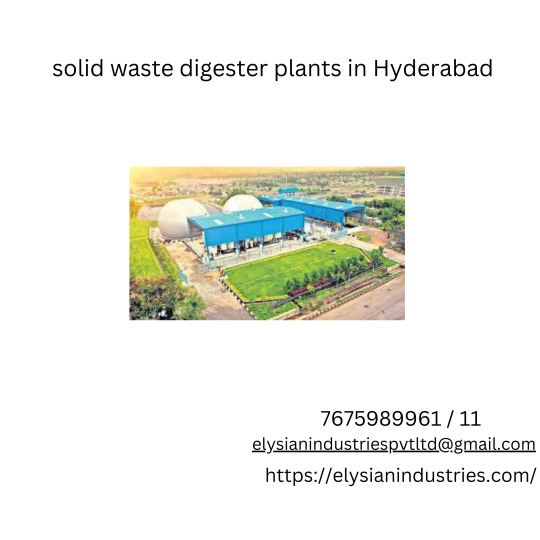
#Solid waste digester plants#Organic waste management#Anaerobic digestion in Hyderabad#Biogas production#Renewable energy generation#Sustainable waste management#Waste-to-energy plants#Environmental sustainability in Hyderabad#Solid waste treatment technologies#Waste management solutions in Hyderabad.
0 notes
Text
Excerpt from this EcoWatch story:
New research has found that recycling food waste using methods such as composting, anaerobic digestion and “refeed” can lead to a dramatic reduction in greenhouse gas (GHG) emissions compared with disposing of it in landfills.
Pressures like population growth, land degradation and urbanization are putting strain on the global agrifood system, which is a major contributor to GHG emissions.
“Everyone is involved in the global agrifood system, since everyone eats food,” said co-author of the study Zhengxia Dou, an agricultural systems professor at University of Pennsylvania (Penn)’s School of Veterinary Medicine, in a press release from the university. “Everyone is a stakeholder.”
Nearly a third of food produced for humans is lost or wasted and never eaten, Dou said. This impacts food security while wasting land, water and energy resources.
“When finished eating, people tend to just toss what’s left: out of sight, out of mind,” Dou said. “But from the resource and environmental perspective, what happens after actually matters a lot.”
The researchers analyzed data from 91 field studies conducted in 29 countries in order to provide “a benchmark for countries developing food waste management strategies for a circular agrifood system,” the authors of the study wrote.
To determine the lifecycle-based effect of food waste recycling on GHG emissions, the researchers focused on three methods: composting; anaerobic digestion — a process where organic material gets broken down to produce a mixture of carbon dioxide and methane known as biogas, which can then be used as a source of renewable energy; and refeed, which uses suitable food waste as animal feed.
The results provided compelling evidence that food waste recycling using those methods can reduce GHG emission in comparison with landfill disposal.
Food waste contains organic compounds like carbohydrates, and when it gets buried in a landfill, these decompose anaerobically, producing the powerful GHG methane. Methane’s warming effect on the planet is 80 times more powerful than that of carbon dioxide over 20 years.
13 notes
·
View notes
Text

Kieran, a longtime mechanical engineer, had just invented Ireland’s first micro-scale anaerobic biodigester.
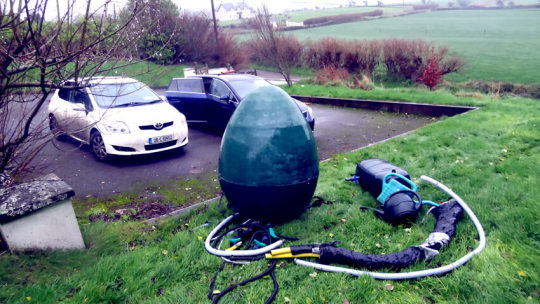
What does one even do with a micro-scale anaerobic biodigester?
Well, this particular anaerobic biodigester takes care of nearly 100% of your food waste.
You feed in all your scraps and waste – even hard-to-compost foods like cooked meats, dairy, cakes and liquids go in. Then the anaerobic bacteria get to work breaking down the waste.
After that, out come two very different ready-to-use products: a biogas for cooking and a nutrient-rich liquid fertiliser for gardening.
Food waste goes in. Gas and fertiliser come out.
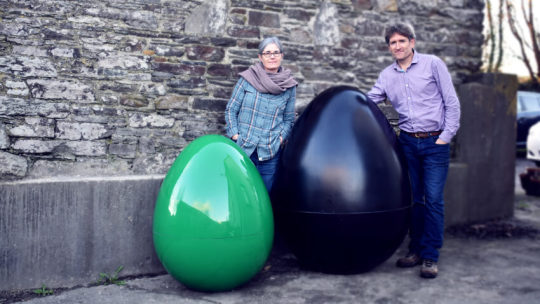
‘We were never really into gardening or growing food. That was the biggest thing to change with the digester,’ Kieran says.
‘During lockdown, we set up the polytunnel and started using the fertiliser from the egg to grow tomatoes and courgettes. Because not only have you got a way to get rid of your food waste, you’ve also got a way to grow more food. And the taste was extraordinary. We had loads of tomatoes so we gave them to friends. They couldn’t get over how tasty they were compared to what they were buying from shops.’
Fiona and Kieran have only seen positives come out of using the egg. They love cooking with the biogas they produce themselves, and having no bill for fertiliser.
#solarpunk#solar punk#reculture#solarpunk aesthetic#solarpunk AF#mygug#ireland#solarpunk innovation#biodigester#food waste into cooking gas and fertilizer#circular food
49 notes
·
View notes
Text
Methane Biogas Digester With ELI Biosciences

Discover the Methane Biogas Digester from ELI Biosciences, an advanced, eco-friendly solution for converting organic waste into renewable energy. Our biogas digesters enhance energy efficiency, reduce carbon footprint, and support sustainable waste management practices. Perfect for both commercial and residential use, the ELI Biosciences biogas digester provides a reliable, cost-effective way to harness methane gas while contributing to a greener future.
0 notes
Text
Versatile Applications of GFS Tanks: A Reliable Solution for Diverse Needs
At Glass Fused Steel Tank, we offer GFS tanks that excel in durability, efficiency, and adaptability. These tanks are widely used in a variety of applications across industries and regions, making them a top choice for water storage and treatment solutions.
Key Applications of GFS Tanks
Water Storage Solutions GFS tanks are perfect for storing large volumes of water in diverse environments. Whether for municipal, industrial, or agricultural purposes, these tanks ensure safe and reliable storage.
Sewer Treatment (STP) Water Tanks Ideal for managing wastewater, GFS tanks support efficient treatment and storage in municipal and industrial sewer systems. Their corrosion resistance and longevity make them a valuable asset for STP facilities.
Effluent Treatment (ETP) Water Tanks Designed for industrial effluent management, GFS tanks facilitate the safe storage and treatment of wastewater, ensuring compliance with environmental standards.
Biogas Digesters GFS tanks serve as durable and efficient biogas digesters, enabling the production and storage of biogas from organic waste, contributing to renewable energy solutions.
UASB Reactors In advanced wastewater treatment processes, UASB (Upflow Anaerobic Sludge Blanket) reactors benefit from the structural integrity and chemical resistance of GFS tanks.
Types of Tanks We Offer
Epoxy Coated Water Tanks These tanks provide superior corrosion resistance, making them ideal for long-term water storage.
Glass Fused Water Tanks Combining the strength of steel with the corrosion resistance of glass, these tanks are versatile and long-lasting.
Galvanized Steel Water Tanks Known for their strength and affordability, galvanized steel tanks are a practical choice for various applications.
GFS Tank Applications Across Regions
Glass Fused Steel Tank in India Supporting diverse industries, our tanks are widely used in India's water storage and treatment projects.
Glass Fused Steel Tank in Indonesia From biogas projects to effluent treatment, our GFS tanks address the needs of Indonesia's growing industrial and environmental sectors.
Glass Fused Steel Tank in Kenya In Kenya, GFS tanks are a preferred choice for sustainable water and wastewater management solutions.
Why Choose Us for GFS Tanks?
Expert Manufacturer and Supplier As a leading manufacturer and supplier of GFS tanks, we prioritize quality, innovation, and customer satisfaction.
Durable and Low-Maintenance Our tanks are built to last, offering minimal maintenance requirements and reduced lifecycle costs.
Sustainable Solutions GFS tanks are designed with sustainability in mind, supporting renewable energy and environmentally-friendly water management projects.
Explore the wide-ranging GFS applications at Glass Fused Steel Tank. Whether you need a reliable biogas digester, an advanced UASB reactor, or robust water storage solutions, we have the expertise to deliver.
#gfs tank#biogas digester#gfs applications#UASB reactors#Manufacturer and supplier of gfs tank#water storage solutions#Sewer Treatment (STP) Water Tanks#Effluent Treatment (ETP) Water Tanks#Epoxy Coated Water Tanks#Glass Fused Water Tanks#Galvanized Steel Water Tanks#glass fused steel tank in India#glass fused steel tank in Indonesia#glass fused steel tank in Kenya
0 notes
Text
Europe Biogas Plant Market Share, Trends, Scope, Analysis and Future Investment Opportunities 2034: SPER Market Research

Biogas plant is a facility that uses anaerobic digestion to turn organic waste materials into dig estate that is rich in nutrients and biogas. Methane (CH₄) and carbon dioxide (CO₂) make up the majority of biogas, with trace amounts of other gases. Biogas is a renewable energy source that can be used to heat buildings, generate electricity, or power cars. The plant breaks down biodegradable materials such as sewage, animal dung, food waste, and agricultural wastes in a controlled, oxygen-free atmosphere using microorganisms. Biogas plants can be modest home units or massive industrial facilities. By turning organic waste into fertilizer and energy, they support circular economies, lower greenhouse gas emissions, and manage garbage sustainably.
According to SPER Market Research, ‘Europe Biogas Plant Market Size- By Feedstock, By Digester Type, By Application- Regional Outlook, Competitive Strategies and Segment Forecast to 2033’ states that the Europe Biogas Plant Market is estimated to reach USD 5.47 billion by 2033 with a CAGR of 9.44%.
The market for biogas plants in Europe is being pushed by a growing emphasis on sustainable waste management and renewable energy. To assist biogas production to meet climate goals and carbon neutrality targets, governments around Europe are putting supportive laws, incentives, and subsidies into place. The move toward decarbonization and rising energy demand have increased investments in biogas infrastructure. Anaerobic digestion technology advancements increase scalability and efficiency, which drives market expansion. The increasing use of circular economy principles promotes the production of biogas from organic waste from municipalities, businesses, and farmers. Furthermore, the need for bio-based fuels, such as bio methane, as an alternative to natural gas, encourages the growth of biogas facilities throughout the area.
Considering the region's emphasis on renewable energy, the European biogas plant industry confronts a number of difficulties. The high upfront and ongoing expenses deter small and medium-sized businesses from implementing biogas technology. Investors face uncertainty due to regulatory complexity and diverse government policies among EU nations. Plant operations are limited by a lack of feedstock, particularly in metropolitan locations. Market expansion is further hampered by competition from other renewable energy sources like wind and solar. Lower energy yields may be the consequence of technological inefficiencies in the upgrading and generation of biogas. Another major obstacle to the market's growth is public opposition to biogas facilities because of worries about its odor, land use, and environmental impact.
Germany dominates the European market for biogas plants mainly due to its vast agricultural sector and advanced waste management systems, which supply a plentiful supply of feedstock for the production of biogas. Some of the key players are - AB HOLDING SPA, EnvitTec Biogas AG, Future Biogas Limited, IES BIOGAS and Naskeo Environmennement S.A.
Request a Free Sample Report: https://www.sperresearch.com/report-store/europe-biogas-plant-market.aspx?sample=1
Europe Biogas Plant Market Segmentation:
By Feedstock: Based on the Feedstock, Europe Biogas Plant Market is segmented as; Bio-Municipal Waste, Agriculture Residue, Energy Crops, Others.
By Digester Type: Based on the Digester Type, Europe Biogas Plant Market is segmented as; Wet Anaerobic Digestion, Dry Anaerobic Digestion.
By Application: Based on the Application, Europe Biogas Plant Market is segmented as; Power Generation, Heat Generation, Transportation.
By Region: This research also includes data for Germany, U.K, France, Spain, Italy, Scandinavia, Benelux, Rest of Europe.
For More Information, refer to below link: –
Europe Biogas Plant Market Growth
Related Reports:
United States Floating Photovoltaics Market Growth, Size, Trends Analysis- By Product, By System, By Application- Regional Outlook, Competitive Strategies and Segment Forecast to 2033
Saudi Arabia Heat Exchangers Market Growth, Size, Trends Analysis- By Type, By End Use Industry- Regional Outlook, Competitive Strategies and Segment Forecast to 2033
Follow Us –
LinkedIn | Instagram | Facebook | Twitter
Contact Us:
Sara Lopes, Business Consultant — USA
SPER Market Research
+1–347–460–2899
#Europe Biogas Plant Market#Europe Biogas Plant Market Growth#Europe Biogas Plant Market Trends#Europe Biogas Plant Market Size#Europe Biogas Plant Market Share#Europe Biogas Plant Market Demand#Europe Biogas Plant Market Revenue#Europe Biogas Plant Market competition#Europe Biogas Plant Market analysis#Europe Biogas Plant Market challenges#Europe Biogas Plant Market report#Europe Biogas Plant Market segmentation
2 notes
·
View notes
Text
The Essential Guide to Wastewater Treatment Plants: Turning Waste into Resource
Wastewater treatment plants (WWTPs) are the unsung heroes of urban infrastructure. As they work tirelessly behind the scenes, they transform contaminated water into a clean resource that can be safely returned to the environment or even reused. In this article, we’ll explore the critical role of wastewater treatment plants, their processes, and the benefits they bring to our communities and ecosystems.
Understanding Wastewater: What Is It?
Before delving into the intricacies of treatment plants, it’s vital to understand what wastewater is. Wastewater is any water that has been adversely affected by human activity. This can include:
Domestic Wastewater: From sinks, toilets, and showers in households.
Industrial Wastewater: Generated from manufacturing processes and commercial activities.
Stormwater: Rainwater that collects pollutants as it flows over surfaces.
Proper management of these types of wastewater is crucial for public health and environmental protection.
The Importance of Wastewater Treatment Plants
Wastewater treatment plants are essential for several reasons:
Public Health: Proper treatment of wastewater prevents the spread of waterborne diseases.
Environmental Protection: Treated water reduces pollution in rivers, lakes, and oceans, preserving aquatic ecosystems.
Resource Recovery: Many plants can recover valuable resources, such as nutrients and energy, from wastewater.
Sustainable Practices: Modern WWTPs incorporate technologies that promote sustainability, reducing their carbon footprint.
The Process of Wastewater Treatment
The treatment of wastewater is a complex process that typically involves several stages. Let’s break down these stages:
1. Preliminary Treatment
In this initial stage, large debris such as sticks, leaves, and plastic are removed from the wastewater. This is usually done through screening and grit removal processes.
2. Primary Treatment
After preliminary treatment, wastewater moves to primary treatment, where solids settle to the bottom, forming sludge. This process removes about 50-70% of suspended solids and approximately 30% of biological oxygen demand (BOD).
3. Secondary Treatment
Secondary treatment is crucial for further reducing organic matter. This stage usually involves biological processes, where microorganisms break down organic pollutants. There are various methods used in secondary treatment, including:
Activated Sludge Process: In this method, air is pumped into the wastewater, allowing microorganisms to feed on the organic material.
Trickling Filters: Wastewater is distributed over media, allowing microorganisms to grow and treat the water as it trickles through.
4. Tertiary Treatment
Tertiary treatment is an advanced stage that further polishes the water. This can involve filtration, nutrient removal, and disinfection processes like chlorination or ultraviolet (UV) light treatment. The goal is to ensure that the water is safe for discharge or reuse.
5. Sludge Management
Throughout the treatment process, sludge is generated. This sludge must be treated separately to reduce its volume and make it safer. Common methods include anaerobic digestion, which produces biogas, and composting, which can create a valuable soil amendment.
Innovations in Wastewater Treatment
The landscape of wastewater treatment is evolving, thanks to technological advancements. Here are some innovations transforming the industry:
1. Membrane Bioreactors (MBRs)
MBRs combine biological treatment with membrane filtration, allowing for higher quality effluent and smaller footprint operations. This technology is ideal for areas with limited space.
2. Constructed Wetlands
These engineered ecosystems mimic natural wetlands to treat wastewater. They are cost-effective and environmentally friendly, providing additional habitats for wildlife.
3. Resource Recovery Facilities
Modern WWTPs are increasingly focusing on recovering valuable resources from wastewater. This includes extracting nutrients like nitrogen and phosphorus, which can be used as fertilizers, and capturing biogas for energy production.

The Benefits of Wastewater Treatment Plants
Investing in wastewater treatment has far-reaching benefits:
1. Economic Advantages
Efficient wastewater treatment supports local economies by ensuring clean water for industries and agriculture. It also creates jobs in engineering, operations, and maintenance.
2. Environmental Sustainability
By reducing pollution and conserving water resources, wastewater treatment plants contribute to a healthier planet. They play a critical role in combating climate change by mitigating greenhouse gas emissions from untreated wastewater.
3. Improved Public Health
Access to treated wastewater prevents health risks associated with untreated sewage. This is especially crucial in developing regions where sanitation infrastructure may be lacking.
Challenges Facing Wastewater Treatment Plants
Despite their importance, wastewater treatment plants face several challenges:
1. Aging Infrastructure
Many WWTPs are outdated and require significant investment to upgrade. Aging systems may lead to inefficiencies and increased pollution.
2. Climate Change Impacts
Extreme weather events and rising sea levels can impact the operation of wastewater treatment facilities. Adapting to these changes is crucial for future resilience.
3. Public Awareness and Engagement
Many communities are unaware of the vital role that WWTPs play. Increasing public engagement can foster support for necessary investments and improvements.
Conclusion: The Future of Wastewater Treatment
Wastewater treatment plants are more than just facilities for cleaning water; they are essential components of sustainable urban development. As technology continues to evolve, these plants will become even more efficient and capable of recovering resources, ultimately contributing to a circular economy.

By recognizing the importance of wastewater treatment and supporting innovations in the field, we can ensure that our communities remain healthy and our environment is preserved for future generations. Investing in wastewater treatment Plant is not just about managing waste; it’s about embracing a sustainable future.
2 notes
·
View notes
Text
Chapter 200 Trivia (Part 1)

The Perseus is back!
There is oil in the Amazon, but the main sources of it are upstream of Manaus and northeastern Argentina, accounting for ~1.12% of current worldwide shares. I'm not sure whether or not this is accessible to the KoS right now, but Chelsea's statement seems incorrect.
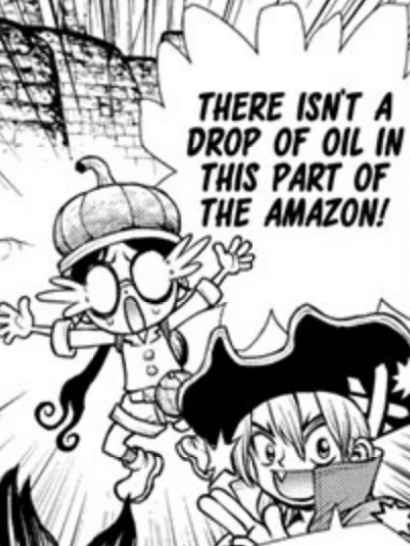

Compared to "future energies" such as solar and wind power, biofuel is a little more controversial due to its industrial sources, deforestation, and the fact it can still pollute like a fossil fuel when burnt. It isn't as bad fossil fuels though, biogas burns cleaner.
Senku struggles to lift heavy objects, but then raises the contents of the outhouse above his head…


Biofuel is made basically exactly as Senku says, by mixing any organic waste products together and letting it ferment (anaerobic digestion if you want to be technical), then collecting the gas as energy and using the leftover solids as fertiliser.

If that explanation is still confusing, the whole process is basically like how your body works: you eat food, your stomach digests it and absorbs the energy, then any waste product is disposed of.
The only difference is there's no real body to fuel, you simply store the energy.
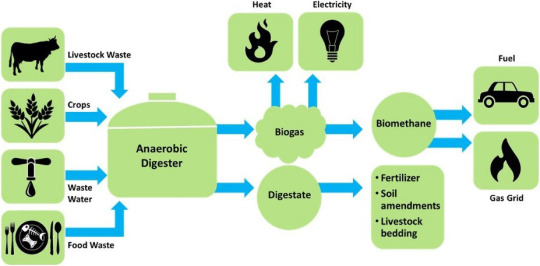
Since the biofuel is a gas, it needs to be converted to a liquid for transportation and use in engines. This is what the Fischer–Tropsch process is for.
The process itself involves fixing the hydrogen to carbon monoxide ratio, then applying heat and pressure to get liquid fuel.
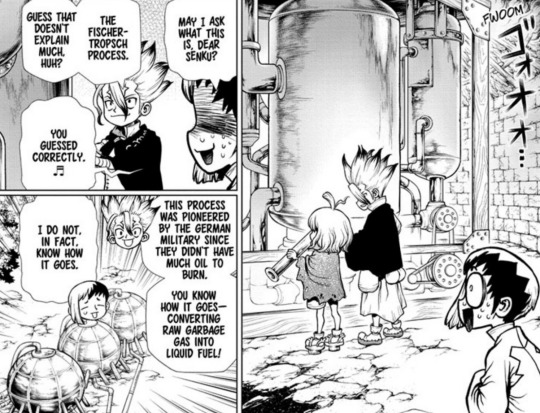

The spherical gas container is called a Horton sphere, and what Senku says is correct, so the only thing missing is a video because everyone loves explosions.

This is a oxyhydrogen torch which is normally used for small-scale welding jobs as it's safer and more economical to use than gas torches.
You can also make them yourself.
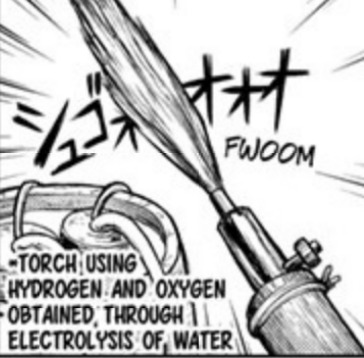

Has Chrome's science-using officially leveled up? He's been working with Xeno while Senku works with Suika. The science mentor/mentee parallel here is really nice!

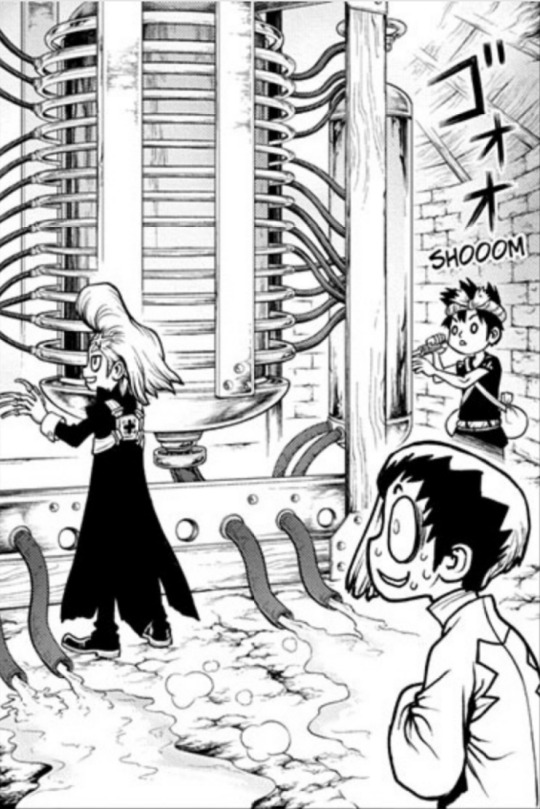
Inconel is actually a family of superalloys of oxidation-corrosion-resistant materials that are also very strong and very good at holding up to high temperatures. As such, it tends to be used in extreme environments like space.


"It's just a rock" is a common theme in Dr. Stone, but it matches the series extremely well. A single rock can't do much on its own, but with a little work and some team-ups, that rock can go to space :)



Since the calendar is between Chrome saying "half a year" and what looks like a time skip sequence, I think the date of April 5750 is somewhere in the middle rather than on either end, which isn't very helpful for a specific timeline.


This timeskip mimics the one in chapter 99 while they made the old Perseus, but is a lot shorter to add in the team and farewell portion of chapter 100.

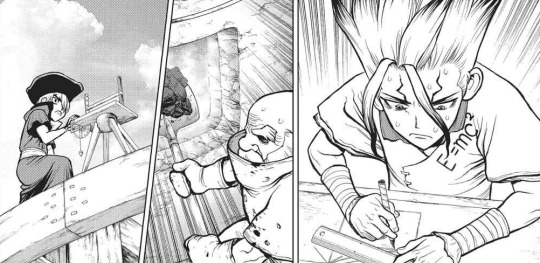

Like last time, Ryusui helps with the design, Kaseki does the crafting (the part he's working on is the prow), while everyone else collects materials.
We also get the South American KoS flag, incorporating the spaceship with the concentric diamonds!




The engine here is a jet engine, Most commonly used in airplanes but have other uses as well. For this, the engine is usually used to generate electricity which then powers other things, such as boat propellers attached to electric motors.


(Next part)
8 notes
·
View notes